
Solidago, commonly called goldenrods, is a genus of about 100 to 120 species of flowering plants in the family Asteraceae. Most are herbaceous perennial species found in open areas such as meadows, prairies, and savannas. They are mostly native to North America, including Mexico; a few species are native to South America and Eurasia. Some American species have also been introduced into Europe and other parts of the world.

Lagoa do Fogo is a crater lake within the Água de Pau Massif stratovolcano in the center of the island of São Miguel in the Portuguese archipelago of the Azores. The highest lake located on the island of São Miguel, the region is protected by governmental regulation that does not permit any constructions around the lake.

Picconia azorica, locally known as pau-branco, is a species of Picconia common to the majority of islands of the Portuguese archipelago of the Azores, where it is endemic. It can grow to a medium-sized tree, though it is usually found in the form of a shrub. It is threatened by habitat loss.

Ponta dos Rosais is a promontory located along the northwestern coast of the parish of Rosais, municipality of Velas, on the island of São Jorge in the Portuguese archipelago of the Azores.

The Fajã dos Cubres is a permanent debris field, known as a fajã, built from the collapsing cliffs on the northern coast of the civil parish of Ribeira Seca, in the municipality of Calheta, island of São Jorge, in the Portuguese archipelago of the Azores.

Solidago sempervirens, the seaside goldenrod or salt-marsh goldenrod, is a plant species in the genus Solidago of the family Asteraceae. It is native to eastern North America and parts of the Caribbean. It is an introduced species in the Great Lakes region. Similar plants found in the Azores are thought have evolved from a natural introduction of this species.

Solidago gigantea is a North American plant species in the family Asteraceae. Its common names include tall goldenrod and giant goldenrod, among others.
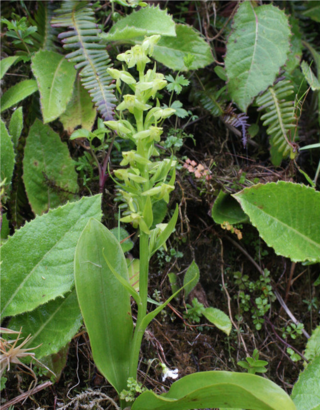
Platanthera azorica, commonly known as Hochstetter's butterfly orchid, is a species of orchid in the genus Platanthera. It was "rediscovered" in 2011 on a single volcanic ridge on the central Azores island of São Jorge, and "is arguably Europe's rarest bona fide orchid species." While P. azorica was previously considered by some sources to be the same as Platanthera micrantha, the 2011 discovery triggered a thorough analysis of historic and current data and specimens, resulting in three species identified.
Myosotis azorica, common name Azorean mouse-ear or Azorean forget-me-not, is a plant species endemic to the Azores Islands in the North Atlantic Ocean.
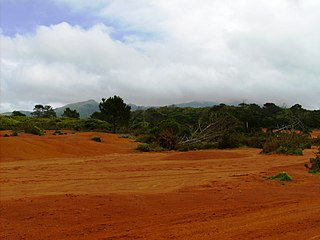
The Protected Landscape of Barreiro da Faneca is a geological region and protected landscape of the Portuguese island of Santa Maria, Azores. The protected area is given its name by the Barreiro da Faneca, nicknamed the "Red Desert of the Azores", an arid and clayey landscape formed during the Pliocene, unique not only to the island but to all of Portugal.

The Azores temperate mixed forests is a temperate broadleaf and mixed forests ecoregion of southwestern Europe. It encompasses the Azores archipelago in the Atlantic Ocean. These volcanic islands are an autonomous region of Portugal, and lie 1500 km west of the Portuguese mainland.

Baixo Islet, also known locally as Ilhéu do Carapacho and historically as Ilhéu dos Homiziados, is a small uninhabited islet group located off the southeast coast of the island of Graciosa in the Portuguese archipelago of the Azores. Along with Praia Islet to its north, Baixo Islet is one of two main breeding places of Monteiro's storm petrel, an endemic marine bird of the Azores.

Vila Franca Islet is a vegetated uninhabited islet located off the south-central coast of the island of São Miguel in the Portuguese archipelago of the Azores. The entire islet and surrounding waters constitute a protected nature reserve, while remaining a popular destination for swimming and cliff diving.
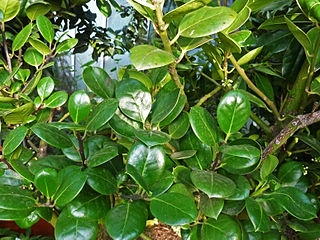
Ilex perado, the Macaronesian holly, is a species of holly endemic to Macaronesia, distributed throughout the Azores, Madeira and Canary islands. It is an important component of the natural high-altitude Macaronesian rainforest, known as 'laurisilva', found mostly at 500 to 1,200 m altitude but it also appears in forest formations at lower elevation. Many of the subspecies have been classified as threatened, probably because of very small population sizes, and are protected by local, national and regional legislation.

Erica azorica is a species of heath endemic to the Azores.

Sanicula azorica, the Azores sanicle, is a perennial plant in the family Apiaceae. It is endemic to the Azores, Portugal.

Lysimachia azorica is a species of flowering plant in the family Primulaceae. It is endemic to the Azores, Portugal and is commonly found in woods, shrubland, forest plantations, embankments, roadsides and paths, in Sphagnum formations, at altitudes generally above 200 m (660 ft). It is present in all of the nine Azorean islands.
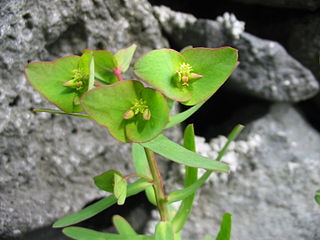
Euphorbia azorica is a species of flowering plant in the spurge family Euphorbiaceae, endemic to the Azores, Portugal.

Veronica dabneyi, the Azores speedwell, is a flowering plant species of the family Plantaginaceae, endemic to the Azores. It inhabits very humid rocky slopes, and also close to waterfalls and lake margins, at altitudes between 200 and 600 m. It is present only in the Western Group of islands. It was thought to be extinct as it had not been observed since 1938, but was rediscovered in 1999, making it a Lazarus taxon.
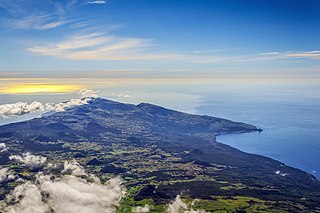
The Achada Plateau is an extensive volcanic mountain range located on Pico Island, Azores. It is a protected area with many valuable features that characterize the Azorean landscape. It is included in two Natura 2000 sites, one of which is classified as an Important Bird Area. Part of the plateau also includes a ramsar wetland. It is one of the three main geomorphological units that comprise Pico Island.



















